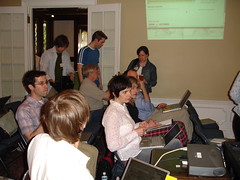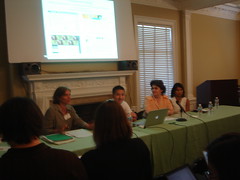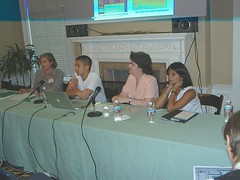While the presentations happen in front, the back channel discussion projects on the left at the Social Software in the Academy Workshop at the Annenberg Center
Since I’ve returned from the SSAW, I’ve been turning over in my mind the experience of backchanneling. A few things stand out. First, when I was presenting myself, I was very much aware that most people were looking down at their laptops rather than up at me, and I called attention to that fact by commenting that I would stand up rather than sit down during my presentation. Second, when I knew there was a backchannel with a sidebar discussion going on, I had to be on it–or at least on the main one. There were others, too, but I tried not to be greedy. Being on the backchannel was fun and informative. Links, questions, comments–all flew by in fast forward speed. Was this so different from the paper and pencil backchannel I often have when a colleague sits next to me at a lecture, and we write commnets to each other in a notebook? Maybe, this is more honest, I wondered, because the speaker can see these notes later.
Mote asked a similar question right after the Conference:
Backchannel was good, and backchannel was fun, but was I the better or worse for having participated in it?
Looking back, though, I remember more about the presentations I heard the first morning before I was on the backchannel. Maybe I was born too late to be part of the ADD generation, but I definitely suffered from “continuous partial attention” during several of the later presentations. The important question is–is that at bad thing? At home, I frequently watch a movie or the news with a magazine or a laptop open. How do we know what is worth giving our full attention to if our full attention is never there? Eventually, will we lose the ability to pay full and complete attention to anything?
Years ago, when I taught junior high school, I had a trick to get my hormone-driven 7th and 8th graders focused. Everything in their bodies and lives pulled them away from writing and books, and I had to fight for their attention with every trick I had. At the beginning of class, I’d form an “A” with the index finger of my left hand and the index and third finger of my right hand, and I’d hold that “A” high above my head. “Give me your Undivided Attention!” I bellowed at first. Later, I shortened it to “Undivided A,” and, finally, I only had to form the “A” with my fingers to settle my class and begin to teach. Here’s my dilemma now: I don’t always want to give my undivided attention, but I sure still want to get it.
 I have used with my Jane Austen & Film First-Year Seminar.
I have used with my Jane Austen & Film First-Year Seminar.

 Segue discussions can be viewed as threaded or flat, and I don’t think students had trouble following the discussion. Segue, also, makes it easy for the faculty member to track student participation in the discussion.
Segue discussions can be viewed as threaded or flat, and I don’t think students had trouble following the discussion. Segue, also, makes it easy for the faculty member to track student participation in the discussion.


 One of the things I love about setting up class blogs, is that I can link outward to a myriad of resources in the real world and link inward to
One of the things I love about setting up class blogs, is that I can link outward to a myriad of resources in the real world and link inward to